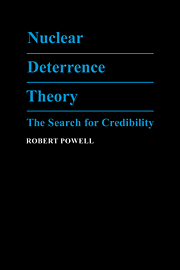Book contents
- Frontmatter
- Contents
- Preface
- 1 Introduction
- 2 The nuclear revolution and the problem of credibility
- 3 The dynamics of nuclear brinkmanship
- 4 Stability and longer brinkmanship crises
- 5 Crisis stability in the nuclear age
- 6 Stability and the lack of control
- 7 The strategy of limited retaliation
- 8 An appraisal
- Appendix Some introductory notes on game theory
- References
- Index
4 - Stability and longer brinkmanship crises
Published online by Cambridge University Press: 13 October 2009
- Frontmatter
- Contents
- Preface
- 1 Introduction
- 2 The nuclear revolution and the problem of credibility
- 3 The dynamics of nuclear brinkmanship
- 4 Stability and longer brinkmanship crises
- 5 Crisis stability in the nuclear age
- 6 Stability and the lack of control
- 7 The strategy of limited retaliation
- 8 An appraisal
- Appendix Some introductory notes on game theory
- References
- Index
Summary
The preceding chapter examined the effects of various changes on the escalatory dynamics of brinkmanship crises. Such examinations are always bound by the limits of the model used in the investigation. One limitation of the model developed in Chapter 3 was that in order to simplify the analysis, the maximum length of a crisis in the model was fixed exogenously and was, moreover, assumed to be very short. In the longest possible crisis, the challenger would dispute the status quo, and both the defender and challenger would take two steps toward the brink, after which the defender would submit. These simplifications reduced the complexity of the analysis, but they made it impossible to study crucial aspects of the approach to deterrence based on the array of risk. One could not, for example, compare the effects on stability of being able to take smaller, less dangerous steps toward the brink and the effects of being able to take only larger and more dangerous steps.
This chapter begins to examine the dynamics of longer brinkmanship crises. In the model to be developed here, there is no exogenous restriction on the number of steps that the states can take. In these longer crises, states generally become less and less likely to escalate as the crisis unfolds. Each also becomes more and more confident that its adversary is resolute. If, therefore, two irresolute states are actually facing each other, misperception will grow worse throughout the crisis.
- Type
- Chapter
- Information
- Nuclear Deterrence TheoryThe Search for Credibility, pp. 85 - 109Publisher: Cambridge University PressPrint publication year: 1990



